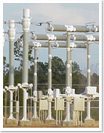Protective Relay Calculations and Settings
 PCS has extensive experience in the development of protective relay settings for transmission, distribution and generation systems, with voltage ranging from 480V through 500 kV. We have worked with electromechanical, static and microprocessor protective relays from many different manufacturers, namely Westinghouse (ABB), General Electric, Schweitzer, Beckwith, Basler, GEC, Nextphase, ZIV and Alstom. We have developed settings for literally thousands of microprocessor relays in the past ten years.
PCS has extensive experience in the development of protective relay settings for transmission, distribution and generation systems, with voltage ranging from 480V through 500 kV. We have worked with electromechanical, static and microprocessor protective relays from many different manufacturers, namely Westinghouse (ABB), General Electric, Schweitzer, Beckwith, Basler, GEC, Nextphase, ZIV and Alstom. We have developed settings for literally thousands of microprocessor relays in the past ten years.
Our experience in the development of relay settings includes the following:
- Transformer differential
- Bus differential — high impedance and low impedance
- Fast bus distribution blocking scheme
- Breaker control — breaker failure, sync check and reclosing
- Capacitor control and protection
- Reactor protection
- Generator protection — distance, volts per hertz, under/over voltage, reverse power, loss of excitation, phase overcurrent, negative sequence overcurrent, stator ground, out of step and differential
- Line protection — multi-zone step distance (up to five zones using SEL 421 relays), permissive overreaching via mirror bit fiber, permissive overreaching via two frequency carrier, directional comparison blocking via single frequency carrier, DCB via microwave mirror bit with standby power line carrier, permissive unblocking via tone or two frequency carrier, phase comparison, current differential (two and three terminal schemes) and series-compensated lines
We are accustomed to performing short circuit calculations and coordination as part of a comprehensive relay protection package. At present, we primarily use ASPEN OneLiner for loop fed utility systems and SKM or ETAP for radial industrial and power plant systems. We are, however, accustomed to adopting the use of short circuit and coordination software used by our clients. We also use the power system lab and EMTP-RV analysis software to model and study power system and equipment transients and stability.
Documentation requirements vary among our clients. We are accustomed to providing calculation and relay setting documentation in meticulous detail. If a client desires abbreviated documentation, we are prepared to provide such.
Calculations are often done in Microsoft Excel, although we have also used other tools and can adapt to the needs of our clients. Several PCS clients prefer relay settings presented in Microsoft Excel. PCS has developed several Excel macros designed to convert files exported from SEL 5010 or AcSELerator into a custom formatted Excel viewable document. Relay settings from any relay manufacturer can also provided in Adobe PDF type format for viewable documents if the client desires.
Our Engineering Services
Call (225) 275-2438
to discuss your next project